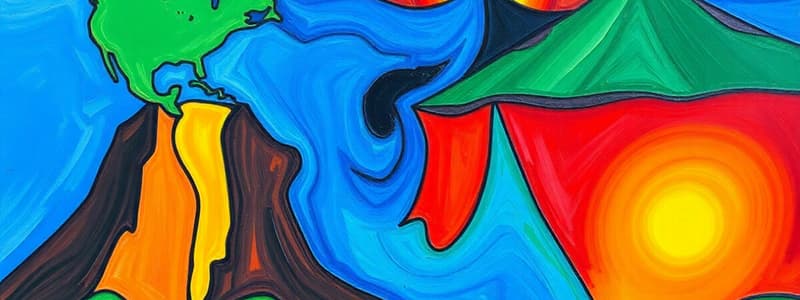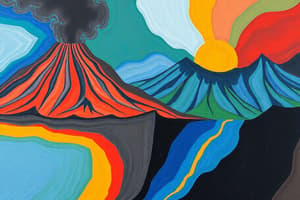Podcast
Questions and Answers
Who first proposed the hypothesis of continental drift?
Who first proposed the hypothesis of continental drift?
- Dr. Marie Curie
- Dr. Isaac Newton
- Dr. Alfred Wegener (correct)
- Dr. Charles Lyell
What is the layer of Earth below the crust called?
What is the layer of Earth below the crust called?
- Asthenosphere
- Lithosphere
- Mantle (correct)
- Core
What is the correct analogy used to describe tectonic plates floating on the mantle?
What is the correct analogy used to describe tectonic plates floating on the mantle?
- A raft on a lake
- A car on a road
- A float in a swimming pool (correct)
- A plane in the sky
What is the maximum speed at which tectonic plates typically move?
What is the maximum speed at which tectonic plates typically move?
Tectonic plate boundaries are significant because they are locations where:
Tectonic plate boundaries are significant because they are locations where:
Which part of the Earth is broken up into large chunks called tectonic plates?
Which part of the Earth is broken up into large chunks called tectonic plates?
What primary force causes tectonic plates to move?
What primary force causes tectonic plates to move?
Once scientists understood what caused the continents to drift, which theory was developed?
Once scientists understood what caused the continents to drift, which theory was developed?
What geological features are formed when tectonic plates push rock together?
What geological features are formed when tectonic plates push rock together?
How do earthquakes relate to the movement of tectonic plates?
How do earthquakes relate to the movement of tectonic plates?
What is a common result of an underwater earthquake?
What is a common result of an underwater earthquake?
Where are most volcanoes located in relation to tectonic plates?
Where are most volcanoes located in relation to tectonic plates?
What pattern is observed between mountain ranges and tectonic plate boundaries?
What pattern is observed between mountain ranges and tectonic plate boundaries?
Which tectonic plate interaction can lead to the formation of ocean trenches?
Which tectonic plate interaction can lead to the formation of ocean trenches?
Which of the following locations experiences a high frequency of earthquakes due to tectonic plate boundaries?
Which of the following locations experiences a high frequency of earthquakes due to tectonic plate boundaries?
What factor enables magma to rise to the surface, resulting in volcanic activity?
What factor enables magma to rise to the surface, resulting in volcanic activity?
Flashcards are hidden until you start studying
Study Notes
Plate Tectonics
- Earth's crust is broken into large chunks called tectonic plates
- Tectonic plates float on top of the mantle, a layer of molten rock beneath the crust
- Plates move slowly due to the movement of magma underneath them
- The movement of tectonic plates causes changes to the Earth's landscape
- Plate boundaries are where tectonic plates meet and interact
- They can move towards each other, away from each other, or side to side
Effects of Plate Tectonic Movement
- Mountains are formed when plates push rock together
- The Mid-Atlantic Ridge is a mountain range on the ocean floor
- Earthquakes occur when plates become stuck and then suddenly shift
- Earthquakes can cause tsunamis when they occur near underwater plate boundaries
- Volcanoes are formed when magma rises to the surface
- The location of mountain ranges, earthquakes, and volcanoes are all related to plate boundaries
Studying That Suits You
Use AI to generate personalized quizzes and flashcards to suit your learning preferences.



